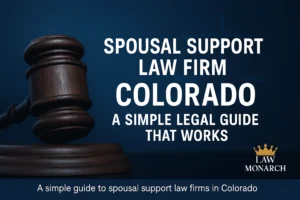Ending a marriage is hard. It changes your life, your home, and your plans. Divorce is not only emotional. It is also a legal process. In California, the law allows you to file without blaming anyone. You can say that your marriage has “irreconcilable differences.” That is enough for the court to accept your case.
Many people feel lost when they start. Court forms, rules, and fees can seem confusing. You do not need to be a lawyer to file. You only need to follow the steps. This guide shows you how to begin, what to expect, and what to prepare.
California has a clear system. But if you miss a form or forget a deadline, it can slow things down. The right steps help you avoid stress and save time. If your case is simple and you both agree, the process can go smoothly. If you have children or property to divide, it may take longer.
This guide explains each part of the divorce process in California. It covers who can file, what forms you need, how to serve your spouse, and how to finish the case. Follow each step in order. You will feel more in control.
Meet the Residency Rules
Before you file, check if you meet the rules. You or your spouse must live in California for at least six months. You must also live in the county where you file for at least three months. These rules apply to everyone.
If you moved to California recently, you can start with a legal separation. Once you meet the time rules, you can change it to a divorce. The court will not accept your case if you file too early.
Always check your address history before filing. It helps you avoid mistakes. If the court rejects your forms, you may have to start over.
Choose the Right County
You must file in the county where you or your spouse lives. Most people file where they live. If you both live in different counties, the one who files first decides the location.
Each county has its own court. Some use extra forms or steps. You can find this information on your county court’s website. Read the rules before you file.
Filing in the right place saves time. If you file in the wrong county, the court may reject your case or delay it.
Complete the Divorce Forms
Start with the main forms. You must fill out the Petition (Form FL-100). This form tells the court what you want. Include your requests about money, property, and children. You must also fill out the Summons (Form FL-110). This tells your spouse about the case.
If you have children under 18, you must also fill out Form FL-105. This form gives the court details about your children. The court uses it to decide custody.
If you own things together, use Form FL-160 to list your property and debts. This helps the court understand your situation.
Make three copies of each form. Keep one copy for yourself. File the second with the court. Give the third to your spouse.
File the Forms With the Court
Take your completed forms to your local family court. Go to the clerk’s window and file them. As of now, the court fee is about $435. You must pay this when you file.
If you cannot afford the fee, ask for a fee waiver. Use Form FW-001. You must show your income and expenses. If approved, you do not have to pay.
After filing, the court gives you stamped copies of your forms. The clerk also gives you a case number. Keep this number safe. You need it for all future steps.
Serve the Forms to Your Spouse
Next, your spouse must receive the court papers. You cannot hand them over yourself. Ask someone 18 or older to deliver them. This person can be a friend, relative, or a professional server.
Your spouse must receive the forms in person. If they agree, you can send the forms by mail. They must sign a special form called FL-117 to confirm they got them.
The person who served the papers must fill out a Proof of Service form (Form FL-115). This form shows the court that your spouse knows about the case. File this with the court right away.
Wait for a Response
After being served, your spouse has 30 days to respond. If they file a Response (Form FL-120), the case becomes contested. This means the court may need to hold hearings.
If your spouse does not respond, you can ask for a default. The court may decide the case without their input. But you still must complete all the forms and follow each step.
Whether your case is contested or not, the court needs full details to issue a final divorce.
Exchange Financial Information
California law requires both spouses to share full financial details. This is called disclosure. You must tell the court what you earn, own, and owe.
Fill out Form FL-140 (Declaration of Disclosure), Form FL-150 (Income and Expense), and Form FL-142 (Assets and Debts). You may also use FL-160 again for detailed property lists.
Serve these forms to your spouse. Do not file them with the court unless they are final. Both spouses must be honest. Hiding assets can cause legal problems.
This step helps the court divide things fairly. It also helps decide support and custody, if needed.
Reach an Agreement If Possible
If you and your spouse agree on all issues, your case will move faster. You can sign a Marital Settlement Agreement. This agreement lists your plans for custody, support, and property.
Many people use mediation to reach a deal. Some courts offer free help. If you agree, the judge may approve your deal without holding a hearing.
If you cannot agree, the court will hold hearings. A judge will decide issues like child custody, support, or property division. The process may take longer, but the court will help you resolve the matter.
Submit Final Forms to the Court
To complete your divorce, you must file final papers. These include:
- Judgment (Form FL-180)
- Notice of Entry of Judgment (Form FL-190)
- Any custody or support agreements
The judge reviews your papers. If everything looks correct, they will sign the judgment. The court will mail you a copy or give one at the clerk’s window.
Your divorce does not become final right away. California has a six-month waiting period. This starts on the date your spouse received the first papers.
Even if the judge signs your papers early, you are not divorced until the six months end.
Take Final Steps After the Divorce
Once the divorce is final, update your legal records. You may need to change your name, close joint bank accounts, or update your will. Contact your insurance, bank, and employer to share new documents.
If the court ordered support or custody, follow the orders exactly. Keep a copy of the judgment in a safe place. You may need it later.
If your situation changes, you can go back to court. You may request changes to custody, support, or visitation. Always follow legal steps when asking for changes.
Conclusion
Filing for divorce in California follows a clear process. You must meet the residency rules, file the correct forms, and notify your spouse. Then you exchange financial details and either agree on terms or ask the court to decide.
Divorce is never easy. But knowing each step helps you stay calm. You can take it one stage at a time. If you need help, courts offer free legal aid. You can also talk to a lawyer to protect your rights.
Take your time. Be honest. Stay organized. A smooth process helps you move forward with peace.
Legal Disclaimer:
This article gives general legal information. It does not give legal advice. Speak to a licensed attorney for help with your case. Laws and court rules may change. Always check with your local court.




